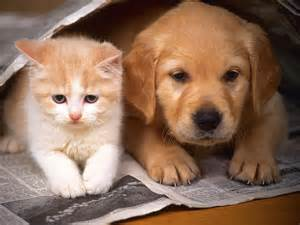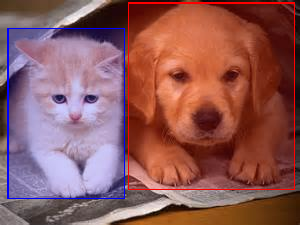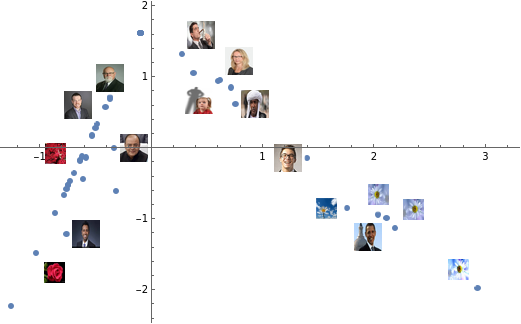5.7 Convolutional Neural Network
5.7 Convolutional Neural Network
5.7.1 Problems in Computer Vision
5.7.1 Problems in Computer Vision
In[]:=
session=StartExternalSession["Python"]
Out[]=
ExternalSessionObject
Test
In[]:=
5+6
Out[]=
11
In[]:=
MapImageIdentify[#]&,
,
,
,
Out[]=
,,,
In[]:=
c=
,
,
,
,
,
,
,
,
.
;
In[]:=
FindClusters[c,Method{"DBSCAN","NeighborsNumber"1.1}]//Column
Out[]=
, , , , , , , , . |
In[]:=
i=
;
In[]:=
u=ImageBoundingBoxes[i]
Out[]=
{Rectangle[{7.98709,26.7497},{124.229,196.438}]},{Rectangle[{128.687,35.4593},{294.344,222.035}]}
In[]:=
Head[u]
Out[]=
Association
In[]:=
z=u,u
Out[]=
{{Rectangle[{7.98709,26.7497},{124.229,196.438}]},{Rectangle[{128.687,35.4593},{294.344,222.035}]}}
In[]:=
HighlightImage[i,{Blue,z[[1]],Red,z[[2]]}]
Out[]=
5.7.2 Feature Extraction via AutoEncoder
5.7.2 Feature Extraction via AutoEncoder
In[]:=
persons=MapImageResize[#,{28,28}]&,
,
,
,
,
,
,
,
,
,
,
,
,
,
,
,
,
,
,
,
;
In[]:=
flowers=MapImageResize[#,{28,28}]&,
,
,
,
,
,
,
,
,
,
,
,
,
,
,
,
,
,
,
,
,
;
In[]:=
mixed=Join[persons,flowers];
In[]:=
Length[mixed]
Out[]=
41
In[]:=
reduced=DimensionReduce[mixed,2,Method"AutoEncoder"];
In[]:=
reduced
Out[]=
{{-5.2981,-4.56879},{-8.49511,-9.12046},{-7.12285,-6.10615},{-6.74473,-6.84916},{-3.57499,-5.54336},{3.45959,-1.67064},{16.4924,-5.98312},{24.7008,-8.44718},{-3.31051,-7.35399},{-0.819933,-0.795893},{-3.9807,-3.45886},{-5.82417,-5.01201},{4.68297,-2.46364},{7.46948,-2.74976},{-5.469,-4.71277},{7.22588,-2.78286},{9.05098,-3.72038},{-3.94466,-3.52982},{-0.819933,-0.795893},{-8.29983,-7.09777},{-8.4925,-7.26009},{-4.44396,-3.84916},{-8.78373,-7.50545},{-11.6509,-9.92104},{-14.2561,-12.116},{-7.68745,-6.58183},{-6.8925,-5.91208},{-8.11164,-6.93921},{-8.29384,-7.09272},{8.58507,-3.04892},{34.1464,-11.3563},{-0.819933,-0.795893},{20.5725,-8.05383},{23.8254,-8.30778},{-0.819933,-0.795893},{25.5779,-8.87099},{-9.64672,-8.23254},{-6.49218,-5.94676},{-7.05887,-6.05225},{-5.88234,-5.06101},{-0.819933,-0.795893}}
In[]:=
r=Standardize[reduced]
Out[]=
{{-0.483559,0.331254},{-0.760158,-1.2166},{-0.641433,-0.191548},{-0.608719,-0.444218},{-0.334479,-0.000161473},{0.274137,1.31681},{1.40171,-0.14971},{2.11188,-0.987644},{-0.311598,-0.615893},{-0.0961182,1.61428},{-0.36958,0.708699},{-0.529074,0.180531},{0.379981,1.04714},{0.621064,0.949837},{-0.498346,0.28229},{0.599988,0.93858},{0.757892,0.619766},{-0.366463,0.684569},{-0.0961182,1.61428},{-0.743263,-0.528761},{-0.759932,-0.583959},{-0.409661,0.575971},{-0.785128,-0.667399},{-1.03319,-1.48885},{-1.25859,-2.23527},{-0.690281,-0.353308},{-0.621503,-0.12555},{-0.72698,-0.474841},{-0.742745,-0.527044},{0.717582,0.848105},{2.92909,-1.97693},{-0.0961182,1.61428},{1.75471,-0.853881},{2.03615,-0.94024},{-0.0961182,1.61428},{2.18776,-1.13177},{-0.859793,-0.914653},{-0.586868,-0.137344},{-0.635898,-0.173218},{-0.534106,0.163867},{-0.0961182,1.61428}}
In[]:=
Length[r]
Out[]=
41
In[]:=
ListPlot[MapThread[Labeled[#1,#2]&,{r,mixed}],PlotStylePointSize[0.01],PlotRangeAll]
Out[]=
5.7.4 Respective Fields
5.7.4 Respective Fields
5.7.5 Spatial Pooling
5.7.5 Spatial Pooling
5.7.7 Image Classification
5.7.7 Image Classification
5.7.8 Image Clustering
5.7.8 Image Clustering
5.7.9 Object Localization and Identification
5.7.9 Object Localization and Identification
https : // resources.wolframcloud.com/NeuralNetRepository/resources/YOLO - V3 - Trained - on - Open - Images - Data
5.7.10 Cat or Dog?
5.7.10 Cat or Dog?
In[]:=
# Importing the Keras libraries and packages
from keras.models import Sequential
from keras.layers import Conv2D
from keras.layers import MaxPooling2D
from keras.layers import Flatten
from keras.layers import Dense
from keras.models import Sequential
from keras.layers import Conv2D
from keras.layers import MaxPooling2D
from keras.layers import Flatten
from keras.layers import Dense
In[]:=
# Initialising the CNN
classifier = Sequential()
# Step 1 - Convolution
classifier.add(Conv2D(32, (3, 3), input_shape = (64, 64, 3), activation = 'relu'))
# Step 2 - Pooling
classifier.add(MaxPooling2D(pool_size = (2, 2)))
# Adding a second convolutional layer
classifier.add(Conv2D(32, (3, 3), activation = 'relu'))
classifier.add(MaxPooling2D(pool_size = (2, 2)))
# Step 3 - Flattening
classifier.add(Flatten())
# Step 4 - Full connection
classifier.add(Dense(units = 128, activation = 'relu'))
classifier.add(Dense(units = 1, activation = 'sigmoid'))
classifier = Sequential()
# Step 1 - Convolution
classifier.add(Conv2D(32, (3, 3), input_shape = (64, 64, 3), activation = 'relu'))
# Step 2 - Pooling
classifier.add(MaxPooling2D(pool_size = (2, 2)))
# Adding a second convolutional layer
classifier.add(Conv2D(32, (3, 3), activation = 'relu'))
classifier.add(MaxPooling2D(pool_size = (2, 2)))
# Step 3 - Flattening
classifier.add(Flatten())
# Step 4 - Full connection
classifier.add(Dense(units = 128, activation = 'relu'))
classifier.add(Dense(units = 1, activation = 'sigmoid'))
In[]:=
# Compiling the CNN
classifier.compile(optimizer = 'adam', loss = 'binary_crossentropy', metrics = ['accuracy'])
classifier.compile(optimizer = 'adam', loss = 'binary_crossentropy', metrics = ['accuracy'])
In[]:=
# Part 2 - Fitting the CNN to the images
from keras.preprocessing.image import ImageDataGenerator
train_datagen = ImageDataGenerator(rescale = 1./255,
shear_range = 0.2,
zoom_range = 0.2,
horizontal_flip = True)
test_datagen = ImageDataGenerator(rescale = 1./255)
training_set = train_datagen.flow_from_directory('M:/training_setA/training_set',
target_size = (64, 64),
batch_size = 32,
class_mode = 'binary')
test_set = test_datagen.flow_from_directory('M:/test_setA/test_set',
target_size = (64, 64),
batch_size = 32,
class_mode = 'binary')
from keras.preprocessing.image import ImageDataGenerator
train_datagen = ImageDataGenerator(rescale = 1./255,
shear_range = 0.2,
zoom_range = 0.2,
horizontal_flip = True)
test_datagen = ImageDataGenerator(rescale = 1./255)
training_set = train_datagen.flow_from_directory('M:/training_setA/training_set',
target_size = (64, 64),
batch_size = 32,
class_mode = 'binary')
test_set = test_datagen.flow_from_directory('M:/test_setA/test_set',
target_size = (64, 64),
batch_size = 32,
class_mode = 'binary')
Then let us train the network. The test set will be employed as validation set,
classifier.fit_generator(training_set,
steps_per_epoch = 94,
epochs = 5,
verbose=0,
validation_data = test_set,
validation_steps = 30)
steps_per_epoch = 94,
epochs = 5,
verbose=0,
validation_data = test_set,
validation_steps = 30)
score = classifier.predict_generator(training_set)
score
score
It means that the classification on the training set is perfect, 100 %.
Now let us check the test (validation) set.
Now let us check the test (validation) set.
score = classifier.predict_generator(test_set)
score
score
namely 80 % on the test (validation) set.
Since the test set was employed as validation set, let test our CNN on further test samples:
# Part 3 - Making new predictions
import numpy as np
from keras.preprocessing import image
test_image = image.load_img('M:/cat_3.jpg', target_size = (64, 64))
test_image = image.img_to_array(test_image)
test_image = np.expand_dims(test_image, axis = 0)
result = classifier.predict(test_image)
result
import numpy as np
from keras.preprocessing import image
test_image = image.load_img('M:/cat_3.jpg', target_size = (64, 64))
test_image = image.img_to_array(test_image)
test_image = np.expand_dims(test_image, axis = 0)
result = classifier.predict(test_image)
result
# Part 3 - Making new predictions
import numpy as np
from keras.preprocessing import image
test_image = image.load_img('M:/dog_1.jpg', target_size = (64, 64))
test_image = image.img_to_array(test_image)
test_image = np.expand_dims(test_image, axis = 0)
result = classifier.predict(test_image)
result
import numpy as np
from keras.preprocessing import image
test_image = image.load_img('M:/dog_1.jpg', target_size = (64, 64))
test_image = image.img_to_array(test_image)
test_image = np.expand_dims(test_image, axis = 0)
result = classifier.predict(test_image)
result































